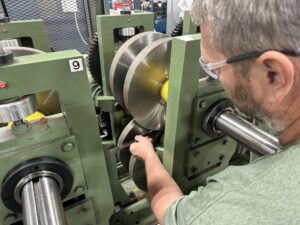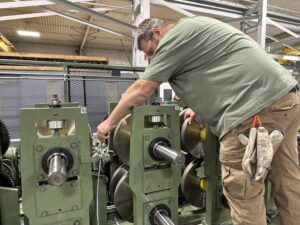
A rollformer only makes money when it is up and running. Therefore, it is critical to keep it operating properly and producing efficiently. Regular rollformer maintenance will prevent long-term breakdowns and expensive repairs. To achieve this, keep the following five tips in mind.
Develop a schedule
The most effective way to ensure regular maintenance of any piece of equipment is to schedule it. Every rollformer comes with a manual outlining the machine’s required maintenance. Review and understand the maintenance instructions provided in the equipment manual thoroughly. It is vital to adhere to the recommended schedules for routine checks, inspections, and servicing outlined by the equipment manufacturer or supplier.
Lubrication routine
Identify critical components that require regular lubrication, including rollers, bearings, and chains. Details for maintaining a proper lubrication schedule should be available from the rollformer manufacturer. It is important to follow these recommendations because the component manufacturer’s engineers have conducted tests to determine the best lubricant for the equipment and the best lubrication frequency requirements.
Rollforming equipment usually has a monitor that determines how many hours it has been running. Run time varies—some customers use a rollformer for eight hours a day, while others may be running three shifts, producing product almost continuously. Busier rollformers will require more frequent maintenance.
Following these recommendations prolongs the life of the equipment and helps maintain the integrity of the manufacturer’s warranty.
Inspect and replace tooling

Regularly inspect the tooling for signs of wear or damage. Most of the tooling is chrome-coated to provide a smooth finish for painted or unpainted products. After years of operation, chrome can wear off, causing the steel in the tooling to wear faster. This can affect the radius of the tooling die, making it larger. This creates a lazy radius instead of the sharp radius desired to properly form products. A mirror-like finish on tooling radiuses is an indicator of tooling wear.
Other damage could be gouging if the tooling runs together. Gouging will affect the quality of the end product. Buildup on the tooling can transfer an impression onto the product or scratch it. Proper lubrication and cleaning prevent galvanizing buildup on the tooling. Wear or damage can cause the rollformer to produce metal products that are inconsistent or do not meet the standards required by customers. Replace worn-out tooling promptly to maintain the precision and quality of the forming process for the products being rollformed.
Align critical components
It is imperative to perform alignment checks on tooling, tooling gaps, and other critical components according to the timelines in the manufacturer’s specifications. Basically, this is checking to ensure that the tooling is calibrated and aligned properly. When initially designed by the engineers, it was a perfect fit. Check the vertical alignment and make sure the horizontal gap is set correctly. This will ensure it is producing a consistent product.
Use precision measuring tools to ensure accurate alignment. If and when any misalignments are detected, address them promptly to prevent issues like uneven profiles or production inconsistencies.
Keep equipment clean
Dirt and dust build up everywhere, so periodically, wipe down the tooling and machine with a soft cloth or clean rags. Dirt and debris build-up is common, whether metal dust or paint dust. When a machine runs 9,144 to 12,192 m (30,000 or 40,000 lineal ft) in a day, there will be buildup. Dirt and debris buildup inhibits finding problems with the rollformer. Monitor the stands and equipment to keep excessive debris from accumulating. This will aid in identifying issues with the equipment before a component fails and leads to a breakdown.
Safety and training
Provide comprehensive training to operators on safe equipment operation and maintenance procedures. Emphasize safety to every employee operating any piece of equipment. Follow a schedule for regular safety checks, ensuring emergency stops, guards, and other safety features are functional. Always maintain detailed records of operator training and safety inspections. Remember to follow a maintenance schedule and keep track of all maintenance. After all, the best way to get a return on investment on a rollformer is to keep it running smoothly.
With 23 years of dedicated service, Ron Dies’s journey at Bradbury began as a service technician, where he mastered technical skills and equipment maintenance.





